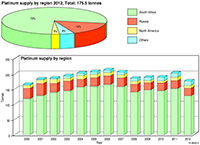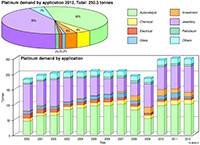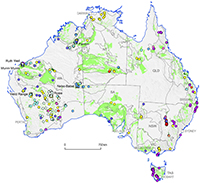Meeting global demand for precious metals in a high-tech world

31 October 2014
Bridgette Lewis, Dean Hoatson and David Huston

Figure 1 Supply data (in tonnes)
for platinum from 2000 to 2012 by region.
Data from Johnson Matthey Market data tables
and Metal price history charts (BASF 2014)
The platinum-group elements (PGEs) are a group of six precious metals considered critical commodities for many emerging technologies globally 1.
These metals have the potential to help meet world demand for a wide range of high-tech and environmentally friendly applications, yet their supply may also be at risk due to geological scarcity, geopolitical issues, trade policies or other factors.
The PGE metals include platinum, palladium, rhodium, iridium, osmium and ruthenium. They have unique physical and chemical properties that make them crucially important for many emerging technologies. They are also often referred to as precious metals because of their rarity and desirability.

Figure 2 Demand data (in tonnes)
for platinum from 2000 to 2012 by application
(use).Data from Johnson Matthey Market
data tables and Metal price
history charts (BASF 2014)
The persistently high prices of PGEs reflect both the increasing demand for these metals and their narrow supply base globally. As an example, supply and demand characteristics for platinum are shown in Figures 1 and 2. Compared with other elements of commercial interest, the PGEs represent some of the most critical of the commodities of global economic importance and as a consequence are attractive exploration targets for the minerals industry.
Diverse applications for a high-tech world
Osmium, iridium and platinum are the densest metals known, with densities up to 22.59 g cm3. Iridium is notable for being the most corrosion-resistant element, even at temperatures as high as 2000°C. The PGEs also have some of the highest melting points of all metallic elements, ranging from 1555°C for palladium to 3033°C for osmium. Other important properties include strength, resistance to wear, a shiny lustre, ductility, malleability, electrical and thermal conductivity.
These attributes mean they have diverse applications in the chemical, electrical, electronic, motor vehicle, aerospace, jewellery, dentistry and agriculture industries, in addition to key applications as catalytic converters and fuel cells in environmentally-friendly technologies.
The world's current supply of platinum-group elements is dominated by South Africa's Bushveld Igneous Complex and Russia's Noril'sk-Talnakh region. In 2013, 178.5 tonnes of platinum were produced worldwide, dominated by South Africa (71.8 per cent) and followed by Russia (13.6 per cent), Zimbabwe (6.9 per cent) and North America (5.5 per cent). Most of the 200 tonnes of palladium were produced by Russia (42.0 per cent) and South Africa (36.6 per cent), with minor contributions from North America (14.5 per cent) and Zimbabwe (4.8 per cent).
In the same year, Australia produced 786 kg of palladium and platinum valued at approximately $20.4 million, which equates to about 0.2 per cent of total global supply. This production was wholly derived as a by-product from nickel-copper-PGE sulphide deposits in Western Australia.
A review of Australia's platinum-group element mineral resources
Despite Australia having favourable geological settings and an abundance of documented PGE occurrences, which indicate that potentially productive mineral systems have been active, Australia does not currently have a significant, economically viable deposit in which PGEs are produced as the main commodity.
An up-to-date comprehensive compilation outlining the distribution, geological characteristics, resources and exploration potential for the Australian PGEs has now been released by Geoscience Australia. The new report comprises 2 of:
- A compilation of known PGE deposits and occurrences in Australia;
- an assessment of the prospectivity and resource potential for PGEs in Australia;
- a mineral-system framework that identifies the mineral forming processes required for the formation of PGE deposits; and
- a series of exploration guidelines that, in conjunction with the mineral system framework, can be used to predict the occurrence of new plays and new deposit types and therefore help to minimise exploration risk.
A mineral systems approach
The major aims of the report are to establish the distribution, geological characteristics, resources and potential of PGEs in Australia; and to develop a mineral-systems-based framework and associated exploration guidelines to reduce exploration risk. It incorporates a range of publically available information and mineral commodity data obtained from the State and Territory geological surveys as compiled in Geoscience Australia's Australian Mineral Occurrences Collection, incorporating the MINLOC database.

Distribution of known Australian
platinum-group-element deposits and
occurrence by mineral-system class.
A mineral-system approach has been used to classify potential PGE deposits and occurrences across Australia using Australian and international type examples. This approach focuses on ore-forming processes critical to the formation of a particular mineral deposit. It differs from more traditional descriptive classifications in that it can also be used to predict new plays and types of PGE mineralisation. Applying the mineral systems approach in this report, indications of prospectivity for Australian PGE mineral systems has been assessed at the continent, province and local-intrusion scale.
Exploration strategies and guidelines for successful low-risk exploration are given for those mineral systems considered more prospective for forming large-tonnage PGE deposits. A complex set of parameters need to be considered for the discovery of such deposits in Australia. This includes the early recognition of mineral potential; a thorough understanding of the mineral system(s); identification of various petrological and geochemical signatures indicating the sulphide-saturation status of magmas.
New techniques: looking under cover
During the last few years there has been an increasing trend of less traditional, innovative exploration methods being considered for exploring mineralised environments in mafic and ultramafic rocks at depth and/or under sediment cover. This apparent paradigm shift in exploration is partly being driven by the demand for elusive world-class deposits and the dramatic decrease in the discovery rate of major mineral deposits globally during the last decade3.

An aerial photograph looking south
over the McIntosh Intrusion, Halls Creek
Orogen, Western Australia.
Image: Ian Oswald-Jacobs,
IOJ Aerial Photography P/L, Adelaide.
Future exploration success will depend on continuing to develop the new technologies and concepts that will stimulate and challenge exploration thinking. The current report provides insights into PGE exploration under cover by documenting features of the mineral systems that will have observable signatures at depth such as density and magnetic or electrical contrasts, ultimately reducing exploration risk. A flexible multidisciplinary approach, exploration persistence, significant capital investment and elements of serendipity are also likely to be required.
Acknowledgements
We would like to acknowledge the valuable contribution of the authors of the full report: Dean Hoatson, Yanis Miezitis, Subhash Jaireth and David Huston.References
[1] ^ Skirrow, R.G., Huston, D.L., Mernagh, T.P., Thorne, J.P., Dulfer, H., & Senior, A.B. 2013. Critical commodities for a high-tech world: Australia's potential to supply global demand. GA Record 2013/7166 Geoscience Australia, Canberra.[2] ^Hoatson, D.M. and Lewis, B.C. (editors) 2014. Platinum group elements in Australia: geological setting, mineral systems, and potential. GA Record 2014/51 Geoscience Australia, Canberra.
[3] ^Schodde, R., 2010. Global discovery trends 1950-2009: What, where and who found them. PowerPoint presentation at PDAC 2010, 7 March 2010, Toronto, Canada, 31 pp. (Accessed 10 October 2014).




